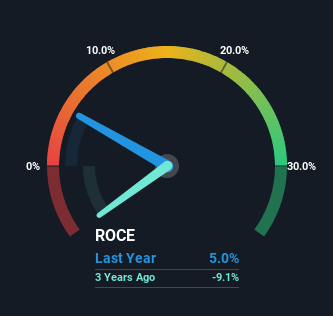- Israel
- /
- Commercial Services
- /
- TASE:AVRT
Capital Allocation Trends At Avrot Industries (TLV:AVRT) Aren't Ideal

What trends should we look for it we want to identify stocks that can multiply in value over the long term? Ideally, a business will show two trends; firstly a growing return on capital employed (ROCE) and secondly, an increasing amount of capital employed. This shows us that it's a compounding machine, able to continually reinvest its earnings back into the business and generate higher returns. However, after investigating Avrot Industries (TLV:AVRT), we don't think it's current trends fit the mold of a multi-bagger.
What Is Return On Capital Employed (ROCE)?
For those who don't know, ROCE is a measure of a company's yearly pre-tax profit (its return), relative to the capital employed in the business. To calculate this metric for Avrot Industries, this is the formula:
Return on Capital Employed = Earnings Before Interest and Tax (EBIT) ÷ (Total Assets - Current Liabilities)
0.05 = ₪8.8m ÷ (₪230m - ₪52m) (Based on the trailing twelve months to June 2023).
So, Avrot Industries has an ROCE of 5.0%. On its own that's a low return on capital but it's in line with the industry's average returns of 5.0%.
See our latest analysis for Avrot Industries

While the past is not representative of the future, it can be helpful to know how a company has performed historically, which is why we have this chart above. If you're interested in investigating Avrot Industries' past further, check out this free graph covering Avrot Industries' past earnings, revenue and cash flow.
What Does the ROCE Trend For Avrot Industries Tell Us?
When we looked at the ROCE trend at Avrot Industries, we didn't gain much confidence. Around five years ago the returns on capital were 6.7%, but since then they've fallen to 5.0%. Although, given both revenue and the amount of assets employed in the business have increased, it could suggest the company is investing in growth, and the extra capital has led to a short-term reduction in ROCE. If these investments prove successful, this can bode very well for long term stock performance.
On a side note, Avrot Industries has done well to pay down its current liabilities to 23% of total assets. So we could link some of this to the decrease in ROCE. Effectively this means their suppliers or short-term creditors are funding less of the business, which reduces some elements of risk. Some would claim this reduces the business' efficiency at generating ROCE since it is now funding more of the operations with its own money.
Our Take On Avrot Industries' ROCE
In summary, despite lower returns in the short term, we're encouraged to see that Avrot Industries is reinvesting for growth and has higher sales as a result. Furthermore the stock has climbed 69% over the last five years, it would appear that investors are upbeat about the future. So should these growth trends continue, we'd be optimistic on the stock going forward.
If you want to know some of the risks facing Avrot Industries we've found 3 warning signs (1 is potentially serious!) that you should be aware of before investing here.
While Avrot Industries may not currently earn the highest returns, we've compiled a list of companies that currently earn more than 25% return on equity. Check out this free list here.
New: Manage All Your Stock Portfolios in One Place
We've created the ultimate portfolio companion for stock investors, and it's free.
• Connect an unlimited number of Portfolios and see your total in one currency
• Be alerted to new Warning Signs or Risks via email or mobile
• Track the Fair Value of your stocks
Have feedback on this article? Concerned about the content? Get in touch with us directly. Alternatively, email editorial-team (at) simplywallst.com.
This article by Simply Wall St is general in nature. We provide commentary based on historical data and analyst forecasts only using an unbiased methodology and our articles are not intended to be financial advice. It does not constitute a recommendation to buy or sell any stock, and does not take account of your objectives, or your financial situation. We aim to bring you long-term focused analysis driven by fundamental data. Note that our analysis may not factor in the latest price-sensitive company announcements or qualitative material. Simply Wall St has no position in any stocks mentioned.
About TASE:AVRT
Avrot Industries
Engages in the lining and coating of steel pipes in Israel.
Flawless balance sheet with solid track record.
Market Insights
Community Narratives



